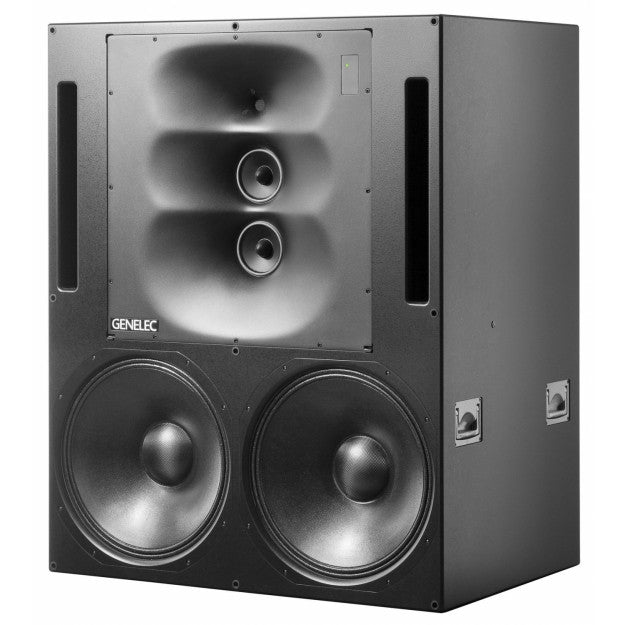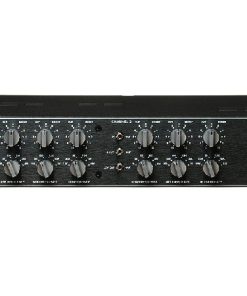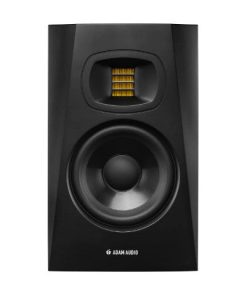Genelec 1236AM SAM Genelec
$ 0,00
Genelec 1236AM Master Monitor
The 1236A SAM is Genelec’s premier main monitor, featuring dual, high-linearity 18″ woofers, along with dual 5″ midrange drivers and a 2″ compression tweeter mounted in large proprietary waveguide, powered by 2x 1000W LF, 2x 400W MF, and 1x 250W HF optimized Class D amplifiers in the rack-mountable RAM-XL amp module, plus remote network GLM speaker management technology – Black finish (M).
When nothing but the biggest and best Genelec has to offer will do, the 1236A is the main monitor system sits at the top of the Genelec Master Monitor range. Built for large control rooms and film post facilities with multi-operator consoles, the 1236A enables engineers to make sonically informed decisions from every nuance of a high track-count mix at all points of the audible spectrum – and feel how the low-frequency effects will be experienced by the listeners. The 1236A’s amplification comprises 2 x 1000W, 800W, and 400W (low, mid, high) Class D amps, outputting 130dB SLP at 6.5 feet. These impressive figures are not just for volume. In order to overcome the inertia of dual 18″ drivers, these power ratings are necessary for accurate transient reproduction and realistic dynamic response across the 1236A’s equally impressive and accurate 21Hz to 20kHz (±2dB) frequency range. The 1236A enclosure features two proprietary high-efficiency 5″ midrange drivers and a 2″ compression driver mounted in a large proprietary waveguide, which creates a very wide and consistent off-axis response (or “sweet spot” as its known in technical jargon), which film post mix teams will find an essential asset. Naturally, the 1236A features Genelec’s networked Smart Active Monitoring with auto-calibration. The Genelec 1236A is where power and finesse meet.
Genelec 1236AM SAM – Just the Facts:
- Complete solution-oriented Smart Active Monitoring systems eliminate guesswork in system configuration and acoustic performance.
- Genelec AutoCal measures the response in the listening area and applies relevant compensation in the low and low-mid frequencies to minimize the detrimental room acoustic anomalies as well as the differences between various listening positions.
- Genelec GLM computer control allows for repeatable, consistent performance
- Genelec advanced Directivity Control Waveguide provides a wide and controlled listening area, minimizing early reflections for very accurate sound reproduction on- and off-axis
- Dual-woofer design extends the control of the directivity along the short front baffle dimension
- The RAM-XL features high-efficiency Class D amplification providing high SPL and dynamic range as well as high reliability with very low distortion
- Thoughtful thermal design makes RAM-XL extremely silent in order to be installed in the listening space
- Genelec Intelligent Signal Sensing (ISS) circuitry switches the system to standby when no audio input is detected, providing significant power consumption savings
-
Genelec quality and reliability ensure a long-term security of investment, low energy consumption, and outstanding audio quality
Genelec 1236AM SAM – Behind the Grille
Extremely powerful, with a peak SPL of 130dB, the tri-amplified 1236A incorporates an individually calibrated, removable RAM-XL Remote Amplifier Module, which is quiet enough to be rackmounted in the control room, thanks to temperature-controlled, forced-air cooling. Unprecedented levels of control are available thanks to the incorporation of Smart Active Monitoring (SAM). Genelec Loudspeaker Manager (GLM™) software allows for the fine adjustment of up to 30 individual Smart monitors and Smart subwoofers to facilitate any multi-channel audio set-up, while AutoCal compensates for adverse room acoustics, perfectly calibrating your system to your listening environment.
Flush wall mounting recommended
While the 1236A can be used effectively as a free-standing monitor, flush mounting is the better way to go for acoustical reasons. Flush mounting forms an infinite baffle*, which improves the bass response and efficiency and enhances the midrange transient and frequency response.
Each 1236A is delivered with the following cable kit:
- One mains cable
- Two 32’9″ (10 m) 4-pole Speakon® cables
- One 32’9″ (10 m) RJ45 cable
- One 16’4″ (5 m) RJ45 cable
* PAD tech note: The infinite baffle (aka sealed cabinet) is one of three main approaches to speaker design (ported reflex and passive radiator being the other two). Infinite baffle is a theoretical concept that deals with the division of sound emanating from the front and rear of the speaker, with both loaded identically in the same infinite volume of air. Since this can’t occur in the real world, the more accurate description is the sealed cabinet. The sound projecting from the front of the speaker only is called “half space,” which is how monitor performance is measured. The sealed cabinet offers a very linear phase response with a shallow bass roll-off, which enables small sealed speakers to reproduce bass at very low frequencies.
Networked Smart Active Monitor (SAM) Systems
Genelec’s advanced SAM Systems can automatically adapt to acoustic environments and correct for levels, delays and room anomalies. SAM Systems can be controlled via Genelec proprietary Loudspeaker Manager (GLM) network and software, enabling you to build a highly flexible and reliable monitoring system. If the monitors have to move between rooms, you can rely on SAM technology to give you absolute consistency, a neutral soundstage, and low distortion. All electronics, drivers, and enclosures are designed, assembled, tested, and calibrated in Genelec’s factory in Finland. Genelec quality and reliability ensure a secure long-term investment, with environmentally conscious, low energy consumption and outstanding audio quality.
AutoCal room calibration
Genelec AutoCal is a system integrator’s dream and gets you out of stasis and into production faster. It facilitates setup by measuring acoustic response in the listening area and applying the appropriate compensation in the low and low-mid frequencies to minimize the muddying effect of room modes and other unwanted room resonances, while simultaneously accounting for the differences between various listening positions.
All this combines with the color-free accuracy of the Minimum Diffraction Enclosure (MDE), and precise on- and off-axis frequency reproduction of the Directivity Control Waveguide (DCW). The result is the ideal small monitor to fit the way you work.
Directivity Control Waveguide (DCW) Technology
Genelec’s Directivity Control Waveguide shapes the emitted wave front of direct radiating multi-way monitors in a way that allows predictable tailoring of the speaker’s dispersion pattern. DCW technology also minimizes early reflections, providing a wide, controlled listening area with accurate sound reproduction both on- and off-axis.
Another advantage of minimized early reflections and controlled constant directivity is that the frequency balance of the room’s reverberation field is essentially the same as the direct field from the monitors. As a result, the monitor’s performance is less affected by room acoustic characteristics.
The consistent off-axis frequency response of the waveguide enables engineers to move in and out of the sweet spot without losing perspective while working.
DCW technology key benefits:
- Flat on- and off-axis response for wider usable listening area
- Increased direct-to-reflected sound ratio for reduced control room coloration
- Improved stereo and soundstage imaging
- Increased drive unit sensitivity up to 6dB
- Increased system maximum sound pressure level capacity
- Decreased drive unit distortion
- Reduced cabinet edge diffraction
- Reduced complete system distortion
Intelligent Signal Sensing function
Genelec’s Intelligent Signal Sensing (ISS) is a power-saving feature that prolongs the service life of the monitor. ISS reduces power consumption to less than 0.5 watts by automatically switching the active monitor to standby when no audio signal has been detected for some time. When playback begins, the mode indicator light on the loudspeaker lights up and the playback resumes after a slight delay (<2 seconds).
Protection circuitry
The protection circuitry prevents driver failure by detecting signal levels and responding accordingly. In the case of sudden peaks or levels that are too high for long periods, the protection circuitry reduces signal level automatically. This feature does not affect the sound quality in any way when working within the specifications of the loudspeaker, but only prevents inappropriate input signals from breaking the loudspeaker.
Protection circuitry features and benefits:
- Reduces the output level when required (e.g. when driver voice coil temperature reaches the safe limit), which highly improves system reliability
- Appropriate protection circuitry design for each loudspeaker and subwoofer maximizes system output level
Room compensation controls
Each room changes the monitor’s response in a unique way, e.g. reflective vs. damped rooms, or placement against a wall vs. on a stand away from the walls. All Genelec loudspeaker systems feature room response adjustments to compensate for the room influences and retrieve a flat frequency response at the listening position. Frequency response can be adjusted to match the acoustic environment by setting the tone control switches on the rear panel of all Genelec monitors.
Optimized amplifiers with active crossover
In a typical 2-way loudspeaker system, the active crossover needs two power amplifiers; one for the woofer and one for the tweeter. Electronic crossovers split the audio signal into separate frequency bands that can be separately routed to individual power amplifiers optimized for the frequency band of their respective transducers.
The power amplifiers are connected directly to the drivers of an active loudspeaker, resulting in the power amplifier’s load becoming much simpler. Each driver-specific power amplifier has only a limited frequency range to amplify (the power amplifier is placed after the active crossover), which adds to the ease of design.
The active design principle offers multiple benefits:
- The power amplifiers are directly connected to the speaker drivers, maximizing the control exerted by the power amplifier’s damping on the driver’s voice coil, reducing the consequences of dynamic changes in the driver electrical characteristics. This may improve the transient response of the system
- There is a reduction in the power amplifier output requirement. With no energy lost in the passive crossover filter components, the amplifier power output requirements are reduced considerably (by up to 1/2 in some cases) without any reduction in the acoustic power output of the loudspeaker system. This can reduce costs and increase audio quality and system reliability
- No loss between amplifier and driver units results in maximum acoustic efficiency
- Active technology can achieve superior sound output vs. size vs. low-frequency cut-off performance
-
All loudspeakers are delivered as a factory aligned system (amplifiers, crossover electronics, and enclosure-driver systems)
The Genelec 1236A is for discerning professionals (who don’t mind a little high-SPL thrill every once and again) working at the highest levels of music and film post-production. For more information integrating a 1236A stereo or multichannel system into your facility, call or chat online with your PAD Studio Specialist today.
Specifications
- Lower cut-off frequency, ”“6dB: 17.5Hz
- Upper cut-off frequency, ”“6dB: 26Hz
- Free field frequency response, ± 2.0dB: 21Hz-20kHz
- Maximum short term sine wave acoustic output on axis in half space, averaged from 100Hz to 3kHz @ 1 m: >130dB SPL
- Maximum long term RMS acoustic output in the same conditions with IEC weighted noise (limited by driver protection circuit) @ 1m: > 125dB
- Maximum peak acoustic output per pair in a listening room with music material @ 2 m: > 136dB
- Self-generated noise level in free space at 2 m on-axis (A- weighted): ≤5dB
Harmonic distortion at 95dB SPL at 1 m on-axis:
- Frequency 50-100Hz: < 1%
- Frequency > 100Hz-3kHz: < 0.5%
- Frequency > 3kHz: < 3%
Drivers
- Bass: 2x 18″ (458 mm)
- Midrange: 2x 5″ (125 mm)
- Treble: 2″ compression tweeter into 1″ (25 mm) throat
Amplifier Section
- Bass amplifier short-term output power: 2x 1000W
- Midrange amplifier short-term output power: 2x 400W
- Treble amplifier short-term output power: 250W
Long-term output power is limited by driver protection circuitry
- Amplifier system THD at nominal output: < 0.003%
Signal-to-noise ratio, referred to full output
- Bass: >116dB
- Midrange: >119dB
- Treble: >115dB
- Mains voltage: 100-120, 220-240 VAC, 50/60Hz
Power consumption
- Standby: 6W
- Idle: 40W
- Full output long term: 1000W
- Full output short term: 2400W
Signal Processing Section
- Analog signal input connector: XLR female, balanced 10k ohm
- Maximum analog input signal: +25dBu
- Analog input sensitivity (100dB SPL at 1 m): -6dBu
- Analog input gain selection: 0, +6, +12, +18dB
- Digital input connector (XLR female 110 ohm): AES/EBU single/dual wire
- Digital output/thru connector (XLR male 110 ohm): AES/EBU single/dual wire
Digital audio input
- Word length: 16/24-bit
- Sample rate: 32kHz ”“ 192kHz
- Digital input sensitivity (100 dB SPL at 1 m): 30dBFS
- Digital input gain selection: 0, +6, +12, +18dB
Control network
- Type: Proprietary GLM network
- Connection: 2x RJ45, CAT5 cables
Crossover frequency
- Bass/Mid: 420Hz
- Mid/Treble: 3.2kHz
GLM software frequency response adjustment
- Notch filters: 4 LF, 2 HF
- Shelving filters: 2 LF, 2 HF
- System calibration: Genelec GLM AutoCal
Physical
- Weight (monitor enclosure): 161 lb. (73 kg)
- Amplifier weight: 25 lb. (11.2 kg)
- Finish: Black
Dimensions (monitor enclosure)
- Height: 37-3/4″ (960 mm)
- Width: 46-1/2″ (1180 mm)
- Depth: 25-5/8″ (650 mm)
Amplifier dimensions (in rack mount configuration)
- Height (front panel): 3U 5-3/16″ (132 mm)
- Width (front panel): 19″ (483 mm)
- Width (amplifier casing): 16-3/4″ (425 mm)
- Depth: 11-1/4″ (286 mm)
| Configuration | Single, Pair |
|---|
Prompt Delivery and Professional Packaging
Our long-standing partnership with UPS FedEx DHL and other global carriers lets us offer a range of shipping services. Our warehouse staff is extremely skilled and will package your items according to our precise and exact specifications. Your goods will undergo an extensive inspection and be safely packaged prior to being sent out. Each day, we ship to thousands of customers in many countries. The fact that we are committed to becoming the biggest online retailer in the World is clear. These warehouses are in Europe in the same way as they are in USA.
Note: Orders that include more than one item are assigned a processing period depending on the item.
Before shipping, we will inspect thoroughly the items you have ordered. Most orders are shipped within 48 hours. Expected delivery time is between 3-7 days.
Returns
Stock is dynamic. It's not entirely managed by us since we are involved with multiple entities, including the factory and the storage. The actual stock can change at any moment. It is possible that your order may be out of stock once the order has been placed.
Our policy lasts for 30 days. We cannot exchange or refund your order if it has been 30 days from the date of purchase.
For your item to be returned it must be in its original packaging, unopened and in the condition you received it. The item must be in its original packaging.
Related products
Microphones
Recording Equipments
Equalizers
Monitor
500 Series
Recording Equipments
Headphones
Monitor Systems
Microphones
Accessories
Monitor
Microphones
Accessories
Recording Equipments
Monitor
Accessories
Accessories
Recording Equipments
Equalizers
Subwoofer
Subwoofer
Monitor
Mic Preamp





































































